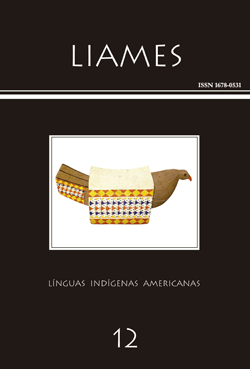Resumen
El objetivo de este trabajo es presentar la interacción, en los verbos transitivos del nivacle, entre el alineamiento inverso (jerárquico) y el macro-papel objeto que distingue entre verbos orientados hacia el tema/paciente, y verbos orientados hacia el recipiente. Por otra parte, el alineamiento inverso prescinde de cualquier morfema directo/inverso, a la vez que aparece un único argumento (ya A, ya P/T o R), elegido según una jerarquía de personas 1 > 2 > 3. El análisis se centra en los argumentos prefijados de los verbos de la quinta conjugación, la única que implica dos argumentos en posición de prefijo.
Citas
CAROL, Javier (2011) Aplicativos/adposiciones en chorote (mataguayo): algunos aspectos formales. LIAMES 11: 51-73.
COMRIE, Bernard (2007) Quelques remarques sur les constructions bitransitives. In M.M.J. Fernandez-Vest (ed.). Combat pour les langues du mondes. Fighting for the world’s languages. Hommage à Claude Hagège, pp. 115-125. Paris: L’Harmattan.
FABRE, Alain (2007) Notas de campo. Consultantes nivacle: Félix Ramírez y Cornelio Gossen (ms.).
FABRE, Alain (2009) El sufijo -sh del nivacle (familia mataco-mataguayo) como instrumental, incremento de valencia y subordinador. In Lucía Golluscio; Alejandra Vidal (eds.). Las lenguas del Chaco. Amerindia 33/34: 43-72.
GERZENSTEIN, Ana (1995) Lengua maká. Estudio descriptivo. Buenos Aires: Instituto de Lingüística, Facultad de Filosofía y Letras, Universidad de Buenos Aires.
GIVÓN, T. (1994) The pragmatics of de-transitive voice: Functional and typological aspects of inversion. In T. Givón (ed.), Voice and inversion, pp. 3-44. Amsterdam: John Benjamins.
HASPELMATH, Martin (2005). Argument marking in ditransitive alignment types. Linguistic Discovery 3/1: 1-21.
HASPELMATH, Martin (2007). Ditransitive alignment splits and inverse alignment. Functions of Language 14/1:79-102.
HASPELMATH, Martin (2011). On S, A, P, T and R as comparative concepts for alignment typology. Linguistic Typology 15/3: 535-567.
KLAIMAN, M. H. (1989). Inverse voice and head-marking in Tanoan languages. Chicago Linguistics Society 25: 258-271.
KLAIMAN, M. H. (1991). Grammatical voice. Cambridge: Cambridge University Press.
KLAIMAN, M. H. (1992). Inverse languages. Lingua 88 (3/4): 227-261.
KLAIMAN, M. H. (1993). The relationship of inverse voice and head-marking in Arizona Tewa and other Tanoan languages. Studies in Language 17(2): 343-370.
MERLAN, Francesca (1985). Split intransitivity: functional oppositions in intransitive inflection. In Johanna. Nichols; Anthony C. Woodbury (eds.). Grammar inside and outside the clause, pp. 324-362. Cambridge: Cambridge University Press.
MITHUN, Marianne (1991). Active/agentive case marking and its motivations. Language 67/3: 510-546.
NICHOLS, Johanna (1986). Head-marking and dependent-marking grammar. Language 62(1): 56-119.
PAYNE, Doris L; BARSHI, Immanuel (1999). External possession. What, where, how, and why. In Doris. L. Payne; Immanuel Barshi (eds.) External possession, pp. 3-29. Amsterdam: John Benjamins.
SEELWISCHE, José (1975). Na lhasinônash napi nivacle. Gramática nivacle. Asunción.
SEELWISCHE, José (1972-1995) Varias cartillas y libros en nivacle. Mariscal Estigarribia, Chaco.
VAN VALIN, Robert, Jr. (1980). On the distribution of passive and antipassive constructions in universal grammar. Lingua 50(4): 303-327.
VIÑAS URQUIZA, María Teresa (1974). Lengua mataca. Tomo 1. Buenos Aires: Centro de Estudios Lingüísticos, Universidad de Buenos Aires.
ZÚÑIGA, Fernando (2002). Inverse systems in indigenous languages of the Americas. Ph.D. Thesis. Zürich: University of Zürich.
LIAMES: Lenguas Indígenas Americanas utiliza la licencia de Creative Commons (CC), preservando así la integridad de los artículos en ambiente de acceso abierto.

